| Author |
Message |
|
Jonathan Hopkins
|
 Posted: Sun 09 Aug, 2009 9:14 pm Post subject: 16th Bengal Cavalry Officer's Scroll Hilt Posted: Sun 09 Aug, 2009 9:14 pm Post subject: 16th Bengal Cavalry Officer's Scroll Hilt |
 |
|
In March of 2008 I decided that I wanted to take my collection in a new, more focused direction. Soon after making this decision I was able to buy a nice Pattern 1897 Infantry Officer’s Sword to an officer of the Indian Army. Researching his life and career sparked an interest in the Indian Army and the various campaigns in the North West Frontier and Afghanistan. I decided to further narrow my collecting efforts to Indian Army officers’ swords. After that initial purchase, however, I struggled to find swords which fit into my framework, and when I did they were out of my price range, or scooped up by other collectors. I was able to satisfy my interests in India, the NWF, and Afghanistan by pursuing swords of officers of the British Army who served in my region of interest. Now, just about a year and a half later, I have had the good fortune of finding a sword to another officer of the Indian Army, and better yet, a special pattern favored by officers in India.

Originating from John Jacob of the Scinde Horse, the scroll hilt (or acanthus hilt) is best known for its brass incarnation in the form of the British Pattern 1857 Royal Engineers Officer’s Sword. But well before 1857 a steel version was favored by officers serving in India, and continued to be produced for discerning officers of both the British and Indian Armies who wanted good fighting swords. My sword, serial number 13539, was made in 1865 for Captain Richard Topham of the 16th Bengal Cavalry. The 1 lb. 14 oz. sword is an excellent example of a weapon intended for service. The steel guard is engraved with an acanthus leaf design. The rest of the weapon is rather Spartan in design. Aside from the standard Wilkinson Pall Mall, and the proof disc, the only blade decoration is the officer’s family crest. The rest of the 34 ¼” blade is plain, and has been sharpened for service. The sharpening begins 8” from the guard and continues to the tip, while almost 7” of the false edge has been sharpened. The scabbard is steel with a German silver mouth, and the inside is lined with wood.


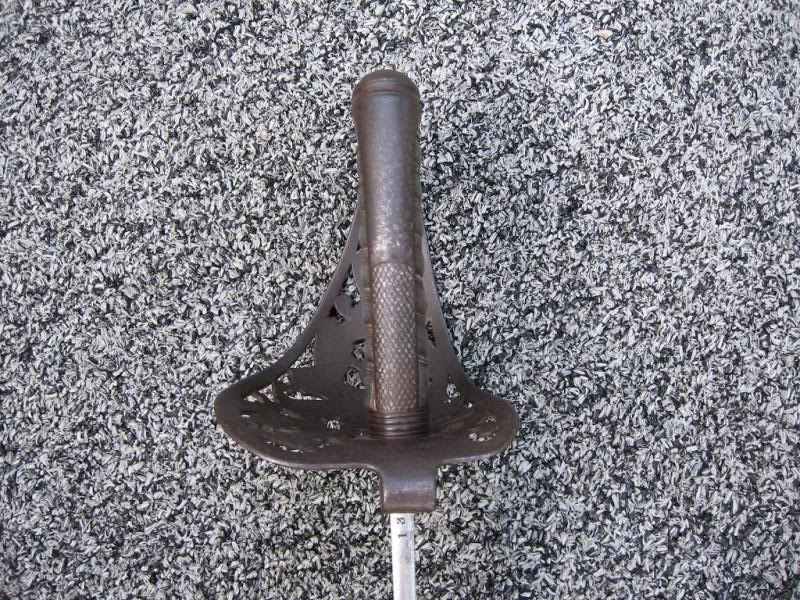

Richard Topham’s first commission was as an ensign in the Royal Lancashire Militia (1st March, 1855). Soon thereafter, he was promoted lieutenant (June, 1855). In July of the same year, he purchased his first regular army commission as a cornet in the 4th (The Queen’s Own) Regiment of Light Dragoons. Less than one year later, on 14 March 1856, Topham was promoted lieutenant (without purchase). At some point in 1857 he transferred top the 7th (The Queen’s Own) Regiment of Light Dragoons (Hussars) and embarked for service in India. Topham served with distinction during the Indian Mutiny (also known as India's First War of Independence, the Great Rebellion, the Indian Rebellion, the Revolt of 1857, the Uprising of 1857 and the Sepoy Mutiny). The Hart’s List for 1860 records:
| Quote: | | Lieut. Topham served in the Indian campaign from Feb. 1858 to March 1859 and was present at the repulse of the enemy’s attack on the Alumbagh, siege and capture of Lucknow, affairs of Barree (wounded) and Sirsee, action of Nawabgunge (contused), occupation of Fyzabad, passage of the Goomtee at Sultanpore, throughout the Byswarra campaign, including the affairs at Kandoo Nuddee, Paleeghat, and Hyderghur, and pursuit of Benhi Madhu's force to the Goomtee; also the Trans-Gogra campaign, including the affair near Churda and pursuit, taking the fort of Meejeedia , attack on Bankee with pursuit to Raptee, advance it to Nepaul and affair at Sitkaghat (twice mentioned in despatches, Medal and Clasp). |
Topham’s mentions in dispatches are recorded in the London Gazette:
| Gazette Issue 22143 published on the 25 May 1858 wrote: | 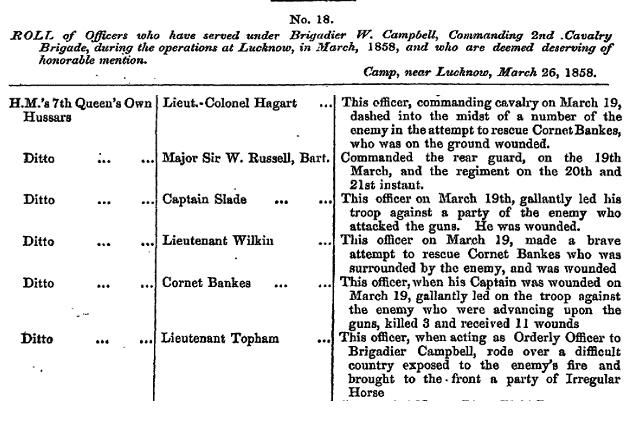 |
| Gazette Issue 22259 published on the 5 May 1859 wrote: |  |
And his actions in the field are recorded in several texts, including The Life of General Sir Hope Grant with selections from his correspondence:
| General Sir Hope Grant wrote: | | On the 13th April we marched at daybreak, but had scarcely gone three miles on our way when I heard the advanced - guard commence firing. The road, or rather track, had been very bad, and I had remained behind to see the heavy guns brought across a nullah. I immediately galloped to the front, and found that a strong cavalry picket of the enemy had attacked our advanced- guard—had surrounded a troop of Wales' Horse, wounding one of the officers, Prendergast1 — and would have taken the two guns which were with it,—when they suddenly perceived a squadron of the 7th Hussars, which the dust had hitherto prevented them from seeing, ready to charge them, whereupon they wheeled about and galloped off. When I reached the scene of the conflict I saw this hostile force, which now amounted to some thousand men, working round our right flank, evidently bent on attacking our baggage, which extended over a line of nearly three miles. I instantly brought up 300 cavalry and two of Mackinnon's guns to protect our flank, and fired several shots at them, but without effect. In addition to our rear-guard, I ordered the Bengal Fusiliers to cover our right flank. I sent a troop of the 7th Hussars to patrol along both flanks, and another squadron to watch the movements of the sowars. The enemy came round in rear of a village, and were in the act of charging upon our baggage when the troop of the 7th Hussars, who were ready prepared for them, dashed down and galloped through them, putting them .to flight and sabring many of their number. Captain Topham, who commanded the troop, and who had run a native officer through the body, was wounded by a lance. He had two men mortally, and six men slightly, wounded. A little after, another body of the rebels charged down upon our baggage, but were met by two companies of the Bengal Fusiliers, who poured a volley into them when within 30 yards distant, which rolled a number in the dust. Thereupon they desisted from further attacks, and retreated as quickly as possible. The infantry were then ordered to advance. The enemy occupied a village on a hill in front of us, at the base of which a stream flowed. Large columns were posted on both sides of this valley. I threw out the Rifle brigade in skirmishing order, supported by the 5th Punjab corps. The main line in rear advanced close up to the village under a heavy fire and stormed it gallantly, capturing two colours. We afterwards advanced and took the higher ground, the rebels bolting without firing a shot. The cowardly fellows might, with a little resolution, have defended the position. |
Following the Mutiny, Topham remained in India and was attached as commandant to the 16th Bengal Cavalry in 1860. Topham purchased his captaincy 16 October 1863. In 1865 Topham officially transferred to the Bengal Staff Corps, and the occasion merited the purchase of his scroll hilt sword. He continued to serve as commandant of the 16th Bengal Cavalry—a position he would keep for the remainder of his career.
Topham’s next and final active service was during the Black Mountain (sometimes called 1st Hazara) Expedition of 1868. He would have carried his new scroll hilt during this campaign. Topham ably commanded his regiment and was mentioned in despatches for his service (William Henry Paget , A Record of the Expeditions Undertaken Against the North-West Frontier Tribes):
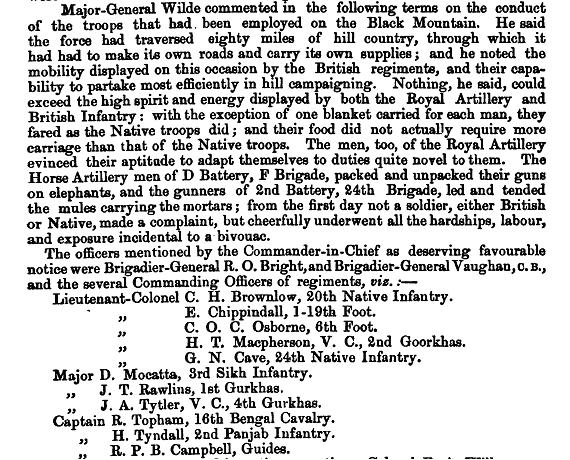
He received further commendations, as well:
| Quote: | 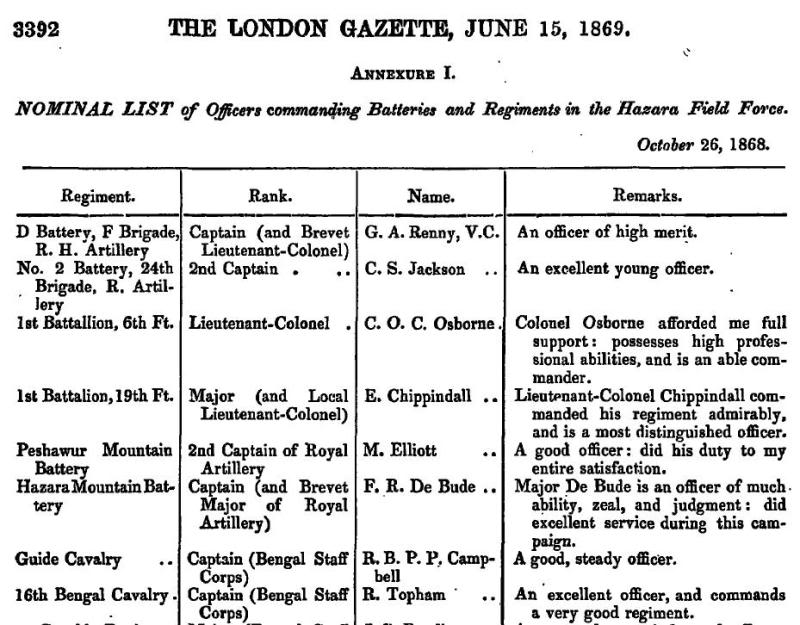 |
The remainder of Topham’s career appears to have been relatively quiet. He continued to command the 16th Bengal Cavalry:
| Parliamentary Papers, 1877 wrote: | 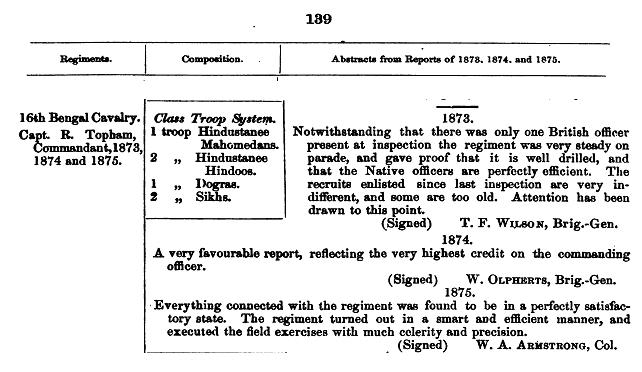 |
Topham was promoted Major on 27 July 1875. Sadly, he died the following year while his regiment was station in Bareilly. I have not been able to determine his cause of death, but cholera seems a likely suspect as there was an outbreak in Bareilly just before he died.
Based on the regiments with whom Topham served, he was probably quite familiar with special patterns and may have owned several throughout his career. The 4th Light Dragoons carried a variation of the scroll hilt which feature their regimental device (see Stephen Wood’s “Swords for the Crimea: some Scottish officers’ swords manufactured for Britain’s war with Russia 1854-56”, Journal of the Arms and Armour Society, London, Vol. XVIII, No. 3, pp 115-135.) In addition to the individual flair of his previous British regiments, Topham would have been influenced by the fashion and preferences of officers of the HEIC and Indian Armies (see Graeme Rimer’s “The swords of John Jacob”, Royal Armouries Year Book 2, 1997), which probably led to the purchase of his final fighting sword.
Last edited by Jonathan Hopkins on Sun 09 Aug, 2009 9:16 pm; edited 1 time in total
|
|
  |
 |
|
Jonathan Hopkins
|
 Posted: Sun 09 Aug, 2009 9:14 pm Post subject: Posted: Sun 09 Aug, 2009 9:14 pm Post subject: |
 |
|
I have yet to address some grime and active rust. I was too excited to post the sword and do the write-up, so I put the task of conservation off for a day. I will post some "after" pics if there is a noticeable difference. Here are some additional images that would not fit into the previous post:

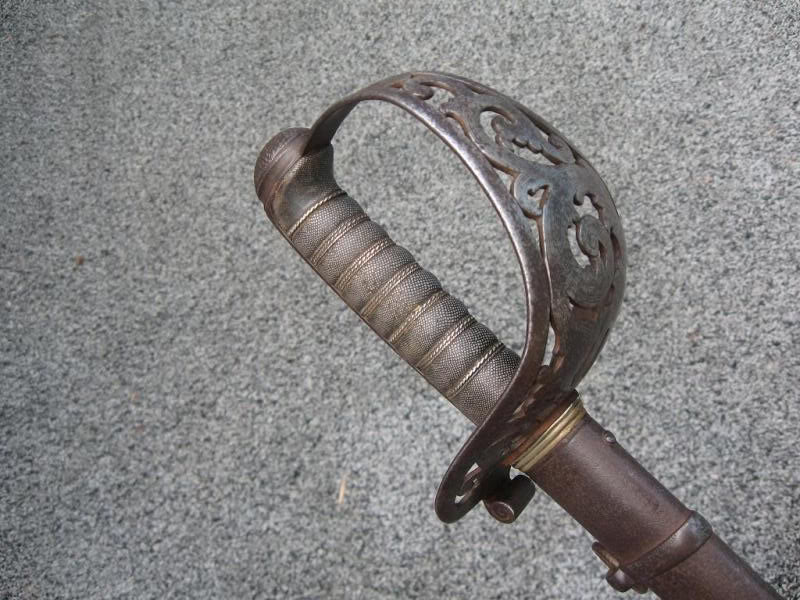
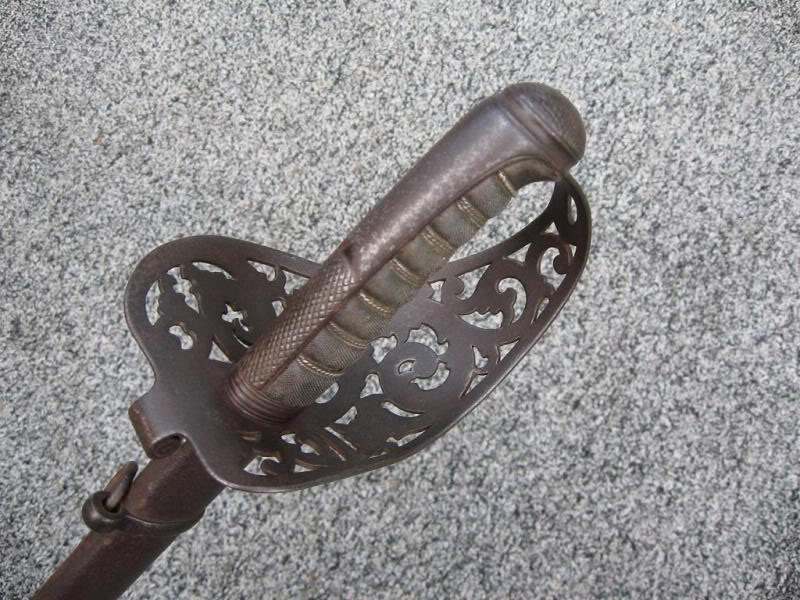

 
|
|
  |
 |
|
Adam S.
|
 Posted: Sun 09 Aug, 2009 9:28 pm Post subject: Posted: Sun 09 Aug, 2009 9:28 pm Post subject: |
 |
|
Jonathan,
That is quite the score! Congratulations on the acquisition of such a marvelous piece.
I really like the small scroll of the guard on the false edge side. It just adds something.
Dimensions?
Thanks for sharing,
~Adam
|
|
  |
 |
|
Jonathan Hopkins
|
 Posted: Sun 09 Aug, 2009 9:33 pm Post subject: Posted: Sun 09 Aug, 2009 9:33 pm Post subject: |
 |
|
Adam,
Thank you for your response! I do not have any precision instruments for measuring, as I only have a tape measure and a postal scale. The dimensions are as follows:
Sword Weight: 1 lb. 14 oz.
Scabbard Weight: 1 lb. 3 oz.
Overall length: 39 3/4"
Blade length: 34 1/4"
Blade width at ricasso: 1 1/8"
Blade thickness at ricasso: 1/4"
Blade sharpening begins 8" from the guard, with 6 3/4" of the false edge being sharpened
Guard width at widest point: 4 1/16"
Guard width at pommel: 5/8"
Guard depth (not including the quillon): ~4 1/4"
The guard, at its widest, is balanced as follows: ~1 1/2" on the inboard side of the blade, and ~2 1/4" on the outboard side of the blade
The guard is approximately 1/16" thick, but without calipers it is hard to get an accurate measurement.
Scabbard length: 35 9/16"
Last edited by Jonathan Hopkins on Mon 10 Aug, 2009 5:07 am; edited 1 time in total
|
|
  |
 |
|
Adam S.
|
 Posted: Sun 09 Aug, 2009 9:37 pm Post subject: Posted: Sun 09 Aug, 2009 9:37 pm Post subject: |
 |
|
Johnathan,
Thank you. Truly a lovely find.
Thanks again for sharing.
~Adam
|
|
  |
 |
Roger Hooper

|
 Posted: Sun 09 Aug, 2009 10:33 pm Post subject: Posted: Sun 09 Aug, 2009 10:33 pm Post subject: |
 |
|
Wow, Jonathan, another beautiful, impressive sword. I find it pleasing that it doesn't have a lot of stuff etched on the blade, and is a Heavy Cavalry sword meant for business, not show. How does this saber feel in your hand? At less then 2 lbs. it should be pretty handy.
Do you know when Richard Topham was born? - Probably sometime in the mid 1830's, which would put him somewhere in his early 40's when he passed on. Do you have any history of this sword after 1876?
I wonder about the sword that Topham was using in 1858, and what happened to it.
|
|
  |
 |
|
Jonathan Hopkins
|
 Posted: Mon 10 Aug, 2009 7:50 am Post subject: Posted: Mon 10 Aug, 2009 7:50 am Post subject: |
 |
|
Adam,
Thanks again for your comments.
Roger,
It is quite nimble--surprisingly so, in fact. I will try to determine an approximate PoB and reply with my findings.
I have not found anything about Topham's birth or family, other than that he married in 1867. I imagine he was born in the mid to late 1830s. I would guess he was between 18 and 20 years of age when he purchased his first commission in 1855.
I do not know exactly what happened to his sword after his death. If WWI practices serve as a lesson, it is possible (and probable, IMO) that his belongings went to his wife. She probably returned to England, where the sword remained until several weeks ago. 
My wife can attest to my general enthusiasm for swords, and my anticipation of this one in particular. Here I am, caught in the act just after the sword arrived on Saturday:
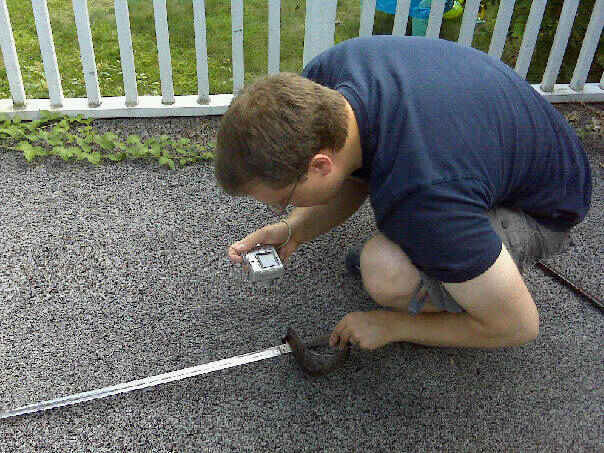
|
|
  |
 |
|
Jonathan Hopkins
|
 Posted: Mon 10 Aug, 2009 1:23 pm Post subject: Posted: Mon 10 Aug, 2009 1:23 pm Post subject: |
 |
|
Roger,
I just noticed your final thought regarding Topham's first sword or swords. His first commission with the Royal Lancashire Militia may have required him to own a Pattern 1854 Infantry Officer's Sword, but who knows if he bothered with one as he was only with that unit for a few months. The 4th (The Queen's Own) Light Dragoons had a a special pattern which is a variant of the scroll hilt, but that does not mean that every officer in the regiment owned one. He may have simply had a standard Pattern 1821 Light Cavalry Officer's Sword. He may have purchased a new sword when he transferred to the 7th (The Queen's Own) Hussars, but I think it is just as likely that he used the sword he already owned up until 1865 when he transferred to the Bengal Staff Corps and bought the scroll hilt which is the subject of this thread. In any case, I am sure he owned several swords over the course of his career.
Jonathan
ADDED:
Just to follow up, the PoB is approximately 5 1/4" from the guard.
|
|
  |
 |
|
Jonathan Atkin
|
 Posted: Mon 10 Aug, 2009 9:04 pm Post subject: Posted: Mon 10 Aug, 2009 9:04 pm Post subject: |
 |
|
Seems to have had a very distinguished career, I wonder if he has any living relations and if they know of his service to the crown? Very nice example of that type of sword though far out of my range of intrest it is indeed intriguing.
"If I must choose between righteousness and peace, I choose righteousness''. - Theodore Roosevelt
|
|
  |
 |
|
|
You cannot post new topics in this forum
You cannot reply to topics in this forum
You cannot edit your posts in this forum
You cannot delete your posts in this forum
You cannot vote in polls in this forum
You cannot attach files in this forum
You can download files in this forum
|
All contents © Copyright 2003-2025 myArmoury.com — All rights reserved
Discussion forums powered by phpBB © The phpBB Group
Switch to the Basic Low-bandwidth Version of the forum
|

